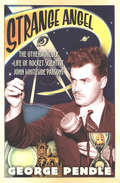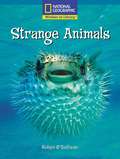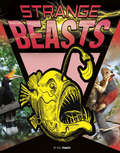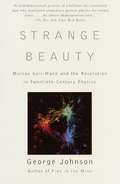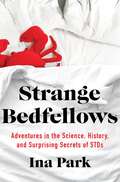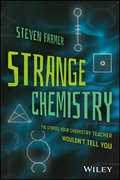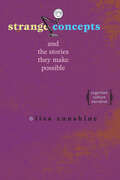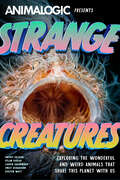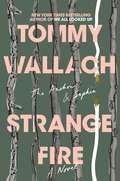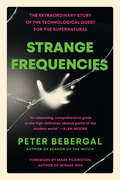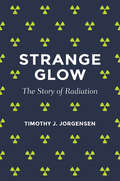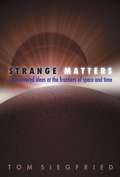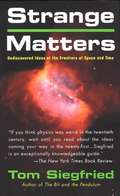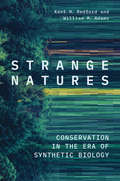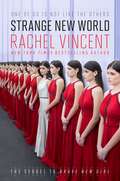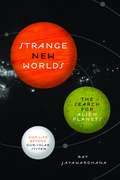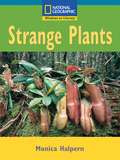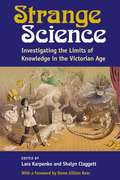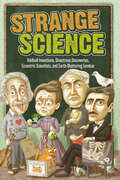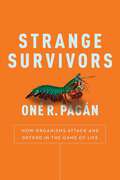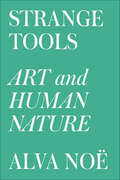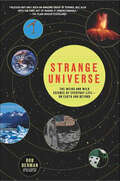- Table View
- List View
Strange Angel: The Otherworldly Life of Rocket Scientist John Whiteside Parsons
by George PendleNow a CBS All Access series: &“A riveting tale of rocketry, the occult, and boom-and-bust 1920s and 1930s Los Angeles&” (Booklist). The Los Angeles Times headline screamed: ROCKET SCIENTIST KILLED IN PASADENA EXPLOSION. The man known as Jack Parsons, a maverick rocketeer who helped transform a derided sci-fi plotline into actuality, was at first mourned as a scientific prodigy. But reporters soon uncovered a more shocking story: Parsons had been a devotee of the city&’s occult scene. Fueled by childhood dreams of space flight, Parsons was a leader of the motley band of enthusiastic young men who founded the Jet Propulsion Laboratory, a cornerstone of the American space program. But Parsons&’s wild imagination also led him into a world of incantations and orgiastic rituals—if he could make rocketry a reality, why not black magic? George Pendle re-creates the world of John Parsons in this dazzling portrait of prewar superstition, cold war paranoia, and futuristic possibility. Peopled with such formidable real-life figures as Howard Hughes, Aleister Crowley, L. Ron Hubbard, and Robert Heinlein, Strange Angel explores the unruly consequences of genius. The basis for a new miniseries created by Mark Heyman and produced by Ridley Scott, this biography &“vividly tells the story of a mysterious and forgotten man who embodied the contradictions of his time . . . when science fiction crashed into science fact. . . . [It] would make a compelling work of fiction if it weren&’t so astonishingly true&” (Publishers Weekly).
Strange Animals
by National Geographic LearningDescribes unusual things animals do to keep safe. A leveled reading book (level 22).
Strange Attractors: Chaos, Complexity, and the Art of Family Therapy
by Michael R. Butz Linda L. Chamberlain William G. MccownThe text offers a powerful prism through which behaviour of complex and organic systems can be understood. Leading chaos theorists explain how this paradigm can be applied to understand the dynamics of the family.
Strange Beasts (Anything But Ordinary)
by Nel YomtovAnimals come in all shapes and sizes. Some are cute and cuddly. Some are frightening and fierce. And some are downright strange! Have you ever seen a blobfish? This deep-sea creature looks like a swimming blob. How about a glass frog? You can see right through its skin to its beating heart! Take a look at these amazing animals and many more strange beasts.
Strange Beauty: Murray Gell-Mann and the Revolution in Twentieth-Century Physics
by George JohnsonWith a New Afterword"Our knowledge of fundamental physics contains not one fruitful idea that does not carry the name of Murray Gell-Mann."--Richard FeynmanAcclaimed science writer George Johnson brings his formidable reporting skills to the first biography of Nobel Prize-winner Murray Gell-Mann, the brilliant, irascible man who revolutionized modern particle physics with his models of the quark and the Eightfold Way. Born into a Jewish immigrant family on New York's Lower East Side, Gell-Mann's prodigious talent was evident from an early age--he entered Yale at 15, completed his Ph.D. at 21, and was soon identifying the structures of the world's smallest components and illuminating the elegant symmetries of the universe.Beautifully balanced in its portrayal of an extraordinary and difficult man, interpreting the concepts of advanced physics with scrupulous clarity and simplicity, Strange Beauty is a tour-de-force of both science writing and biography.From the Trade Paperback edition.
Strange Bedfellows: Adventures in the Science, History, and Surprising Secrets of STDs
by Ina Park"Joyful and funny . . . Park uses science, compassion, humor, diverse stories and examples of her own shame-free living to take the stigma out of these infections." —The New York TimesWith curiosity and wit, Strange Bedfellows rips back the bedsheets to expose what really happens when STDs enter the sack.Sexually transmitted diseases have been hidden players in our lives for the whole of human history, with roles in everything from World War II to the growth of the Internet to The Bachelor. But despite their prominence, STDs have been shrouded in mystery and taboo for centuries, which begs the question: why do we know so little about them?Enter Ina Park, MD, who has been pushing boundaries to empower and inform others about sexual health for decades. With Strange Bedfellows, she ventures far beyond the bedroom to examine the hidden role and influence of these widely misunderstood infections and share their untold stories.Covering everything from AIDS to Zika, Park explores STDs on the cellular, individual, and population-level. She blends science and storytelling with historical tales, real life sexual escapades, and interviews with leading scientists—weaving in a healthy dose of hilarity along the way.The truth is, most of us are sexually active, yet we’re often unaware of the universe of microscopic bedfellows inside our pants. Park aims to change this by bringing knowledge to the masses in an accessible, no-nonsense, humorous way—helping readers understand the broad impact STDs have on our lives, while at the same time erasing the unfair stigmas attached to them.A departure from the cone of awkward silence and shame that so often surrounds sexual health, Strange Bedfellows is the straight-shooting book about the consequences of sex that all curious readers have been looking for.
Strange Chemistry: The Stories Your Chemistry Teacher Wouldn't Tell You
by Steven FarmerThis book opens the audience’s eyes to the extraordinary scientific secrets hiding in everyday objects. Helping readers increase chemistry knowledge in a fun and entertaining way, the book is perfect as a supplementary textbook or gift to curious professionals and novices.• Appeals to a modern audience of science lovers by discussing multiple examples of chemistry in everyday life• Addresses compounds that affect everyone in one way or another: poisons, pharmaceuticals, foods, and illicit drugs; thereby evoking a powerful emotional response which increases interest in the topic at hand• Focuses on edgy types of stories that chemists generally tend to avoid so as not to paint chemistry in a bad light; however, these are the stories that people find interesting• Provides detailed and sophisticated stories that increase the reader’s fundamental scientific knowledge• Discusses complex topics in an engaging and accessible manner, providing the “how” and “why” that takes readers deeper into the stories
Strange Concepts and the Stories They Make Possible: Cognition, Culture, Narrative
by Lisa ZunshineIn this fresh and often playful interdisciplinary study, Lisa Zunshine presents a fluid discussion of how key concepts from cognitive science complicate our cultural interpretations of "strange" literary phenomena.From Short Circuit to I, Robot, from The Parent Trap to Big Business, fantastic tales of rebellious robots, animated artifacts, and twins mistaken for each other are a permanent fixture in popular culture and have been since antiquity. Why do these strange concepts captivate the human imagination so thoroughly? Zunshine explores how cognitive science, specifically its ideas of essentialism and functionalism, combined with historical and cultural analysis, can help us understand why we find such literary phenomena so fascinating.Drawing from research by such cognitive evolutionary anthropologists and psychologists as Scott Atran, Paul Bloom, Pascal Boyer, and Susan A. Gelman, Zunshine examines the cognitive origins of the distinction between essence and function and how unexpected tensions between these two concepts are brought into play in fictional narratives. Discussing motifs of confused identity and of twins in drama, science fiction’s use of robots, cyborgs, and androids, and nonsense poetry and surrealist art, she reveals the range and power of key concepts from science in literary interpretation and provides insight into how cognitive-evolutionary research on essentialism can be used to study fiction as well as everyday strange concepts.
Strange Creatures: Exploring the Wonderful and Weird Animals that Share this Planet with Us (Animalogic Presents)
by Andres SalazarLearn about the most beautiful and unusual creatures, all in one incredible animal encyclopedia for adults. Cool animals, fascinating facts. From the hognose snake to the mudskipper, you will learn all about the wacky and wonderful animals that walk, run, swim, and slither all over our magnificent planet. In Strange Creatures, you will get a deeper look into the lives of these glorious animals and learn how connected they are to the world we live in. A book of wild animals living remarkable lives. Step outside of your own world and into the world of Strange Creatures. Look through the eyes of the banana slug, understand how the wolf eel lives, and find out what separates a glow worm from a velvet worm. Discover the eccentric creatures around us and gain a greater view of our world. Inside, you&’ll find: Strange facts about animals that will ignite a passion for cool critters and wow-worthy wildlife A new way to expand your knowledge by learning about a different type of animal every chapter A different perspective on the world through these wonderfully weird animals and their lively stories If you liked Zoology: Inside the Secret World of Animals, Knowledge Encyclopedia, or Coyote Peterson&’s Brave Adventures, you&’ll love Strange Creatures.
Strange Fire (The Anchor & Sophia #1)
by Tommy WallachFor teens who grew up reading and adoring The Giver and The City of Ember. Oregon Trail meets Westworld in this epic new trilogy from the New York Times bestselling author of We All Looked Up, Tommy Wallach.Knowledge has always been the enemy of faith. They said that the first generation of man was brought low by its appetites: for knowledge, for power, for wealth. They said mankind’s voracity was so great, the Lord sent his own Daughter to bring fire and devastation to the world. The survivors were few, but over the course of centuries they banded together to form a new civilization—the Descendancy—founded on the belief that the mistakes of the past must never be repeated. Brothers Clive and Clover Hamill, the sons of a well-respected Descendant minister, have spent their lives spreading that gospel. But when their traveling ministry discovers a community intent on rediscovering the blasphemous technologies of the past, a chain of events will be set in motion that will pit city against city…and brother against brother. Along with Gemma Poplin, Clive’s childhood sweetheart, and Paz Dedios, a revolutionary who dreams of overthrowing the Descendancy, Clive and Clover will each play a pivotal role in determining the outcome of this holy war, and the fate of humanity itself.
Strange Frequencies: The Extraordinary Story of the Technological Quest for the Supernatural
by Peter BebergalA journey through the attempts artists, scientists, and tinkerers have made to imagine and communicate with the otherworldly using various technologies, from cameras to radiowaves.Strange Frequencies takes readers on an extraordinary narrative and historical journey to discover how people have used technology in an effort to search for our own immortality. Bebergal builds his own ghostly gadgets to reach the other side, too, and follows the path of famous inventors, engineers, seekers, and seers who attempted to answer life's ultimate mysteries. He finds that not only are technological innovations potent metaphors keeping our spiritual explorations alive, but literal tools through which to experiment the boundaries of the physical world and our own psyches.Peter takes the reader alongside as he explores: * the legend of the golem and the strange history of automata; * a photographer who is trying to capture the physical manifestation of spirits; * a homemaker who has recorded voicemails from the dead; * a stage magician who combines magic and technology to alter his audience's consciousness; * and more.<
Strange Glow
by Timothy J. JorgensenMore than ever before, radiation is a part of our modern daily lives. We own radiation-emitting phones, regularly get diagnostic x-rays, such as mammograms, and submit to full-body security scans at airports. We worry and debate about the proliferation of nuclear weapons and the safety of nuclear power plants. But how much do we really know about radiation? And what are its actual dangers? An accessible blend of narrative history and science, Strange Glow describes mankind's extraordinary, thorny relationship with radiation, including the hard-won lessons of how radiation helps and harms our health. Timothy Jorgensen explores how our knowledge of and experiences with radiation in the last century can lead us to smarter personal decisions about radiation exposures today.Jorgensen introduces key figures in the story of radiation--from Wilhelm Roentgen, the discoverer of x-rays, and pioneering radioactivity researchers Marie and Pierre Curie, to Thomas Edison and the victims of the recent Fukushima Daiichi nuclear power plant accident. Tracing the most important events in the evolution of radiation, Jorgensen explains exactly what radiation is, how it produces certain health consequences, and how we can protect ourselves from harm. He also considers a range of practical scenarios such as the risks of radon in our basements, radiation levels in the fish we eat, questions about cell-phone use, and radiation's link to cancer. Jorgensen empowers us to make informed choices while offering a clearer understanding of broader societal issues.Investigating radiation's benefits and risks, Strange Glow takes a remarkable look at how, for better or worse, radiation has transformed our society.
Strange Matters
by Tom SiegfriedScientists studying the universe find strange things in two places--out in space and in their heads. This is the story of how the most imaginative physicists of our time perceive strange features of the universe in advance of the actual discoveries.It is almost a given that physics and cosmology present us with some of the grandest mysteries of all. What weightier questions to ponder than, "How does the universe work?" or "What is the universe made of?" There are any number of bizarre phenomena that could provide clues or even answers to these queries. The strangeness ranges from unusual forms of matter and realms of existence to wild ideas about how time and space are related to one another. Many of these proposals may well turn out to be wrong. But how many will be proven to be right?This book speaks for the scientific theorists who are bold enough to imagine and predict the impossible. New ideas are percolating in their heads every day. One physicist may dream of subatomic particles that could resolve a variety of cosmological conundrums while another may study the likes of "funny energy," which may explain how rapidly the universe is expanding. This is the stuff of Strange Matters.In broad terms, this book is about a variety of discoveries that theorists of the past imagined before the observers and experimenters actually saw them. Moreover, it is about the things that today's are now imagining--but haven't yet been discovered or confirmed by the observers. Strange Matters artfully mixes the present with the past and future, reporting from the frontiers of research where history is in the process of being made.Each chapter examines a different step along the twisted path we've walked to gain our rudimentary understanding of the universe, incorporating historical examples of successful "prediscoveries" with current stories that relate brand new ideas. We come to see the universe not only in terms of what has already been discovered, but also in terms of what has yet to be observed.Strange Matters is a guide to the discoveries of the twenty-first century, a series of visions dreamt by the most imaginative scientists of our time merged with the achievements of the past--to point the way towards even greater accomplishments of the future.
Strange Matters: Undiscovered Ideas at the Frontiers of Space and Time
by Tom SiegfriedFrom Publishers Weekly The universe, as physicists have come to know it, is a very strange place, filled with particles known as quarks. Space itself, physicists have come to understand, is curved, and there may well be more than the three spatial and one temporal dimensions we have become accustomed to. Making sense of these fascinating but complex ideas for the general reader is a difficult task, one that science journalist Siegfried (The Bit and the Pendulum) accomplishes deftly, with wit and insight. Siegfried attempts to provide answers to the two basic questions that absorb physicists today: "What is the universe made of?" and "How does the universe work?" Although his answers, like those of the physicists he writes about, are tentative and contingent on the next major discovery, Siegfried brings clarity and a great deal of enthusiasm to the search for understanding. He does a superb job of explaining how mathematical advances have led to an amazing array of "prediscoveries," from the existence of antimatter to the concept of an expanding universe. He also looks to the future and outlines numerous weird possibilities, from minuscule superstrings to parallel universes. Along the way, he presents a thoroughly engaging, if just a bit eclectic, history of physics. Siegfried has turned a difficult subject into a book that is difficult to put down. Copyright 2002 Cahners Business Information, Inc. --This text refers to an out of print or unavailable edition of this title.
Strange Natures: Conservation in the Era of Synthetic Biology
by William M. Adams Kent H. RedfordA groundbreaking examination of the implications of synthetic biology for biodiversity conservation Nature almost everywhere survives on human terms. The distinction between what is natural and what is human-made, which has informed conservation for centuries, has become blurred. When scientists can reshape genes more or less at will, what does it mean to conserve nature? The tools of synthetic biology are changing the way we answer that question. Gene editing technology is already transforming the agriculture and biotechnology industries. What happens if synthetic biology is also used in conservation to control invasive species, fight wildlife disease, or even bring extinct species back from the dead? Conservation scientist Kent Redford and geographer Bill Adams turn to synthetic biology, ecological restoration, political ecology, and de-extinction studies and propose a thoroughly innovative vision for protecting nature.
Strange New World
by Rachel VincentIn a world where everyone is the same, one girl is the unthinkable: unique. The second and final book in this high-stakes, fast-paced sci-fi series from New York Times bestselling author RACHEL VINCENT.Dahlia 16's life is a lie. The city of Lakeview isn't a utopia that raises individuals for the greater good; it is a clone farm that mass-produces servants for the elite. And because Dahlia breaks the rules, her sisters--the 4,999 girls who share her face--are destroyed. She and Trigger 17, the soldier who risked his life for hers, go on the run, escaping into the wild outside the city walls. But it turns out Dahlia has one remaining identical, one who shouldn't even exist. Waverly Whitmore is teenage royalty, a media sensation with millions of fans who broadcasts her every move--including every detail of her wedding planning, leading up to the day she marries Hennessy Chapman. Waverly lives a perfect life built on the labors of clones like Dahlia. She has no idea that she too is a clone . . . until she comes face to face with Dahlia. One deadly secret. Two genetic sisters. And a world that isn't big enough for both of them. "Thrilling and dangerous, with an ending that will leave you gasping!" --SUZANNE YOUNG, New York Times bestselling author of the series THE PROGRAM on book 1, Brave New Girl
Strange New Worlds
by Ray JayawardhanaIn Strange New Worlds, renowned astronomer Ray Jayawardhana brings news from the front lines of the epic quest to find planets--and alien life--beyond our solar system. Only in the past two decades, after millennia of speculation, have astronomers begun to discover planets around other stars--thousands in fact. Now they are closer than ever to unraveling distant twins of the Earth. In this book, Jayawardhana vividly recounts the stories of the scientists and the remarkable breakthroughs that have ushered in this extraordinary age of exploration. He describes the latest findings--including his own--that are challenging our view of the cosmos and casting new light on the origins and evolution of planets and planetary systems. He reveals how technology is rapidly advancing to support direct observations of Jupiter-like gas giants and super-Earths--rocky planets with several times the mass of our own planet--and how astronomers use biomarkers to seek possible life on other worlds. Strange New Worlds provides an insider's look at the cutting-edge science of today's planet hunters, our prospects for discovering alien life, and the debates and controversies at the forefront of extrasolar-planet research. In a new afterword, Jayawardhana explains some of the most recent developments as we search for the first clues of life on other planets.
Strange New Worlds
by Ray JayawardhanaSoon astronomers expect to find alien Earths by the dozens in orbit around distant suns. Before the decade is out, telltale signs that they harbor life may be found. If they are, the ramifications for all areas of human thought and endeavor--from religion and philosophy to art and biology--will be breathtaking. In Strange New Worlds, renowned astronomer Ray Jayawardhana brings news from the front lines of the epic quest to find planets--and alien life--beyond our solar system. Only in the past fifteen years, after millennia of speculation, have astronomers begun to discover planets around other stars--hundreds in fact. But the hunt to find a true Earth-like world goes on. In this book, Jayawardhana vividly recounts the stories of the scientists and the remarkable breakthroughs that have ushered in this extraordinary age of exploration. He describes the latest findings--including his own--that are challenging our view of the cosmos and casting new light on the origins and evolution of planets and planetary systems. He reveals how technology is rapidly advancing to support direct observations of Jupiter-like gas giants and super-Earths--rocky planets with several times the mass of our own planet--and how astronomers use biomarkers to seek possible life on other worlds. Strange New Worlds provides an insider's look at the cutting-edge science of today's planet hunters, our prospects for discovering alien life, and the debates and controversies at the forefront of extrasolar-planet research.
Strange Science: Investigating the Limits of Knowledge in the Victorian Age
by Lara Pauline Karpenko Shalyn Rae ClaggettThe essays in Strange Science examine marginal, fringe, and unconventional forms of scientific inquiry, as well as their cultural representations, in the Victorian period. Although now relegated to the category of the pseudoscientific, fields like mesmerism and psychical research captured the imagination of the Victorian public. Conversely, many branches of science now viewed as uncontroversial, such as physics and botany, were often associated with unorthodox methods of inquiry. Whether ultimately incorporated into mainstream scientific thought or categorized by 21st century historians as pseudo- or even anti-scientific, these sciences generated conversation, enthusiasm, and controversy within Victorian society. To date, scholarship addressing Victorian pseudoscience tends to focus either on a particular popular science within its social context or on how mainstream scientific practice distinguished itself from more contested forms. Strange Science takes a different approach by placing a range of sciences in conversation with one another and examining the similar unconventional methods of inquiry adopted by both now-established scientific fields and their marginalized counterparts during the Victorian period. In doing so, Strange Science reveals the degree to which scientific discourse of this period was radically speculative, frequently attempting to challenge or extend the apparent boundaries of the natural world. This interdisciplinary collection will appeal to scholars in the fields of Victorian literature, cultural studies, the history of the body, and the history of science.
Strange Science: Oddball Inventions, Disastrous Discoveries, Eccentric Scientists, and Earth-Shattering Eurekas (Strange Series)
by Editors of Portable PressThis entertaining compendium of bite-sized articles reveals the stranger-than-sci-fi world of strange science. From the oddest theories to the most astounding discoveries to the biggest blunders, Strange Science has all the facts your professors didn't teach you in science class. It's packed with earth-shattering eurekas, outlandish inventions, silly &“scientific&” studies, and the stories behind the weirdos who made it all happen. Put on your lab coat and get ready to discover . . . One dentist's quest to clone John LennonHow to hypnotize a chickenReal-life time travelers (or so they claim)The seven-year-long study that found earthquakes are not caused by catfish waving their tails . . . and other breakthrough findings Plus you&’ll discover unbelievable inventions; the freakiest franken-foods scientists have created; some of Hollywood&’s worst on-screen science blunders; and more! This amazing volume from the Bathroom Readers&’ Institute contains the strangest short science articles from dozens of Bathroom Readers, along with fifty all-new pages.</
Strange Survivors: How Organisms Attack and Defend in the Game of Life
by One R. PaganLife is beautiful, ruthless, and very, very strange. In the evolutionary arms race that has raged on since life began, organisms have developed an endless variety of survival strategies. From sharp claws to brute strength, camouflage to venom—all these tools and abilities share one purpose: to keep their bearer alive long enough to reproduce, helping the species avoid extinction. Every living thing on this planet has developed a time-tested arsenal of weapons and defenses. Some of these weapons and defenses, however, are decidedly more unusual than others. In Strange Survivors, biologist Oné R. Pagán takes us on a tour of the improbable, the ingenious, and the just plain bizarre ways that creatures fight for life. Inside this funny, fascinating field guide to nature&’s most colorful characters, you&’ll meet killer snails, social bacteria, and an animal with toxic elbows. But Strange Survivors is more than a collection of curiosities—it is a love letter to science and an argument for the continuing relevance of this evolutionary battle as we face the threat of resistant bacteria and the need for novel medical therapies. Whether discussing blood-thinning bats and electric fish or pondering the power of cooperation, Pagán reveals the surprising lessons found in some of life&’s natural oddities and how the tactics they employ to live might aid our own survival.
Strange Tools: Art and Human Nature
by Alva NoëA philosopher makes the case for thinking of works of art as tools for investigating ourselvesIn his new book, Strange Tools: Art and Human Nature, the philosopher and cognitive scientist Alva Noë raises a number of profound questions: What is art? Why do we value art as we do? What does art reveal about our nature? Drawing on philosophy, art history, and cognitive science, and making provocative use of examples from all three of these fields, Noë offers new answers to such questions. He also shows why recent efforts to frame questions about art in terms of neuroscience and evolutionary biology alone have been and will continue to be unsuccessful.
Strange Universe: The Weird and Wild Science of Everyday Life—on Earth and Beyond
by Bob Berman"Touches on a dizzying array of subjects, including UV rays, inert gases, fossils, meteorites, microwaves, rainbows . . . Like many a good teacher, Berman uses humor to entertain his audience and liven things up." —Los Angeles TimesBob Berman is motivated by a straightforward philosophy: everyone can understand science—and it's fun, too. In Strange Universe, he pokes into the bizarre and astonishingly true scientific facts that determine the world around us. Geared to the nonscientist, Berman's original essays are filled with the trademark wit and cleverness that has earned him acclaim over many years for his columns in Astronomy and Discover magazines. He emphasizes curiosities of the natural world to which everyone can relate, and dishes on the little-known secrets about space and some of science's biggest blunders (including a very embarrassing moment from Buzz Aldrin's trip to the moon). Fascinating to anyone interested in the wonders of our world and the cosmos beyond, Strange Universe will make you smile and think.
Strange World: Unlocking the Mysteries of Pluto (Fountas & Pinnell Classroom, Guided Reading Grade 5)
by Christy PetersonA New World Discovered It was a faint point of light, almost too small to be seen, moving slowly through the heavens far beyond the known solar system. Scientists got their first glimpse of Pluto almost a hundred years ago—and they have been trying to solve its mysteries ever since. NIMAC-sourced textbook
